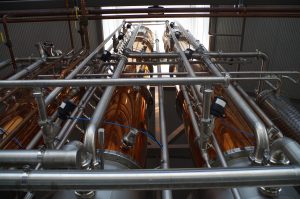Field Trips - Minneapolis Craft Distilleries
All photos by Maggie Kimberl.
On a trip to Minneapolis, Minnesota for the Whiskey on Ice festival, I decided to check out the local distilling scene and get to know some of the folks who are growing craft distilling in the cold far North. There had been a blizzard there just the week before but already it was back to t-shirt weather when I landed, despite the foot high snow berms still piled alongside the roads. One thing I learned while I was there is that people in Minnesota really love their whiskey and will deal with the snow to get it!
First Stop: J. Carver Distillery
Jonathan Carver was an explorer looking for the Northwest Passage who ended up sticking around Minnesota to map and explore the area. The distillery is named for him, and their tagline is “Spirits of Discovery.” Started by a group of spirits professionals, it’s a very small operation based in an old Pontiac dealership near where Prince spent the final days of his life.
Founded in 2012, this distillery already has a spirits portfolio to rival distilleries that have been around much longer. There are four gins, three rye whiskeys, two bourbons, two brandies, two vodkas, two liqueurs and four grappas. What’s more, because of the strict spirits laws in Minnesota they can only make cocktails with their own wares, so they also make their own bitters, vermouths, and other mixers in house so visitors can enjoy a cocktail at the end of their tour.
Coming from Kentucky, I wasn't expecting Waconia to have limestone filtered water, but it turns out those same glaciers that flattened the land as they receded 2.6 million years ago left behind ample limestone rubble there. Grains are plentiful, and especially rye grows really well in that cold Northern climate. All of the grains, fruits, and herbs used at this distillery are grown as near the campus as possible, including farms and orchards right down the road. Employing your neighbors can lead to a great sense of community, as we know quite well back home.
The day I was there it was bottling day for rye whiskey, and even family members had been drafted to help out. The brandies and rye whiskeys impressed me the most, and I even purchased a bottle of the Hunt Club Rye to bring home with me (another of the strange local laws only allows you to buy a 375ml per day). I was also impressed with their gins as a non gin drinker - there was a flavor profile for everyone.
It’s not the easiest place to get to if you are visiting Minneapolis, but it’s well worth the 30 minute drive to check it out.
Second Stop: Dampfwerk Distillery
This tiny distillery is hidden in an industrial park where you could easily assume your GPS had gotten you lost. I was greeted at the door by Olli, the sweetest distillery dog I have ever met. Then the Loeffelholz family led me through a door where I saw something I had never seen before: a Müller still from Germany. I hail from the land of Vendome and 95% of what I see is Vendome with the remaining 5% from Forsyths. This still was precision calibrated to produce fruit brandies like the ones Ralf Loeffelholz remembers from his formative years in Southern Germany as well as the whiskey cordials from his later life in Northern Germany. In fact, he refers to his still as his "Porsche", perfectly tuned to his specifications.
The father-son distilling team of Ralf and Christian compliment each other very well as far as their distilling preferences go. Ralf is mostly interested in the brandies and liqueurs, while Christian wants to branch out to include rye and perhaps even bourbon in the family portfolio. Ralf waxes poetic about the art of distilling while Christian is grounded in science, finishing up a degree in Food Science at the local University. Mary and Bridgit, the mother and daughter side of the family, focus on marketing.
The family makes fruit brandies when the fruit is available and grain whiskeys when the grains are available. When the apples come in, it’s all hands on deck as whole apples get ground in a machine and fed into the fermenters for the long, slow process of fermentation. Some brandies go into the bottle unaged, while others spend a brief time in barrels. When it’s not brandy making season there’s also gin to be made, and the flavor profile varies from a traditional unaged juniper gin to a more herbal style of gin that is aged in French oak barrels.
One of the whiskey cordials is a rye based concoction called the Rabbit and the Rye which contains orange and cinnamon, among other things. It’s a lovely cordial by itself, but I think it would also make a fabulous substitute for vermouth in a Manhattan. I was fortunate enough to get one to bring home for my Manhattan experiments.
These are spirits you can only buy in Minnesota currently, but as this distillery continues to grow, look for it in markets where there is a significant German population. I’ve already pitched Cincinnati and Northern Kentucky!



